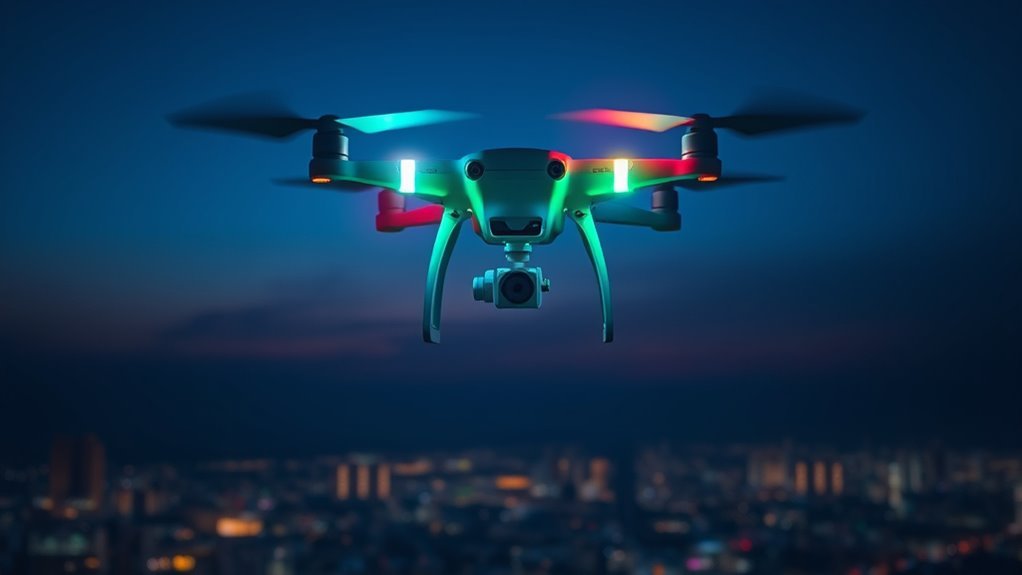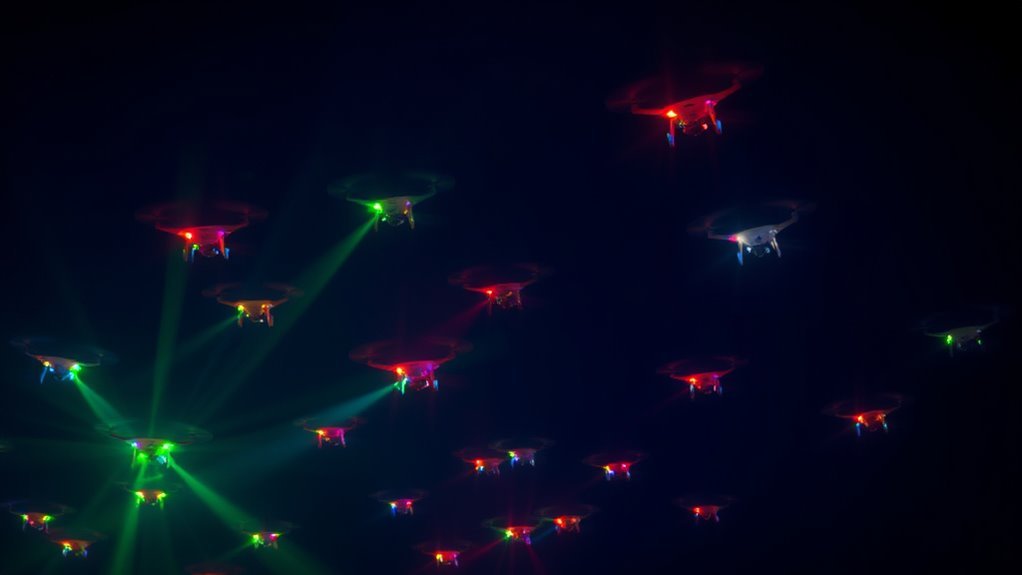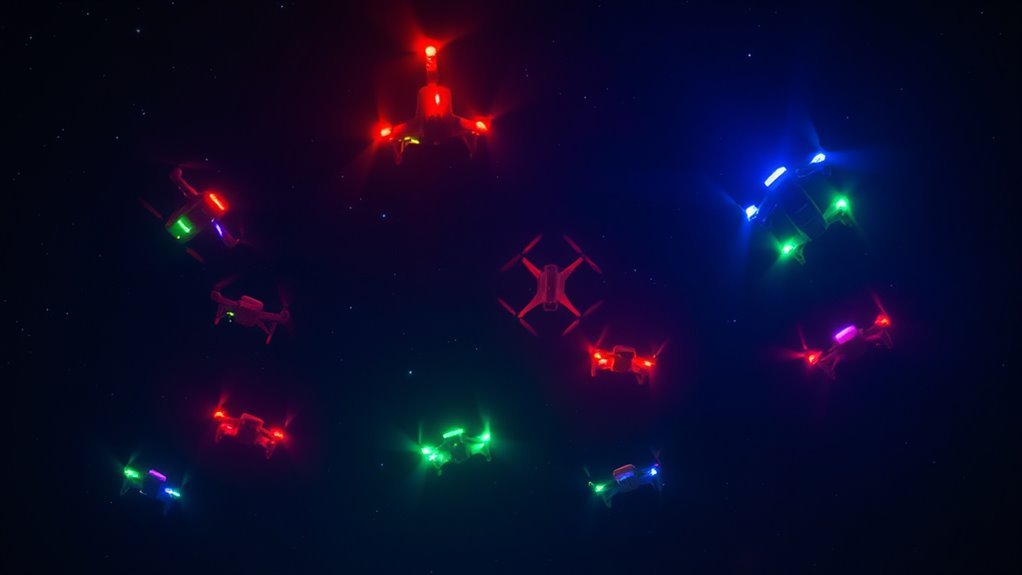At night, drones typically have three main colored lights: red, green, and white. Red lights indicate the left side, while green lights show the right side, enhancing orientation. White lights are used for navigation and overall visibility, making the drone easier to spot. Understanding these color cues is vital for safe operation and compliance with regulations. By knowing their significance, you can enhance your flying experience and avoid collisions—there’s much more to explore about drone lighting!
The Importance of Drone Lights at Night

When you’re flying a drone at night, having proper lighting isn’t just a safety measure; it’s vital for compliance with aviation regulations. Nighttime visibility is essential for both the pilot and others in the airspace. Drones equipped with effective light patterns guarantee that you can easily spot your aircraft, avoiding potential collisions. Additionally, these lights help other pilots and ground observers recognize your drone’s position and orientation. Using bright, consistent light patterns not only enhances your situational awareness but also promotes responsible drone operation. Remember, the freedom to fly your drone at night comes with the responsibility to adhere to safety standards, guaranteeing a safe experience for yourself and others in the sky.
Common Colors of Drone Lights

Three common colors of drone lights are red, green, and white, each serving a distinct purpose in nighttime operations. Red lights are typically used on the left side of the drone, signaling its position to other pilots and guaranteeing safety during night flights. Green lights indicate the right side, providing a clear visual reference for orientation. These drone light colors enhance night flight visibility, allowing you to maintain situational awareness and avoid collisions. While white lights are often reserved for navigation and visibility, red and green lights are vital for identifying the drone’s direction and status. Understanding these colors can enhance your flying experience and guarantee compliance with regulations, ultimately granting you the freedom to operate safely in the night sky.
White Lights: Navigation and Visibility

White lights on drones play an essential role in navigation, helping you maintain awareness of your aircraft’s position in the dark. They enhance flight safety by making your drone more visible to others, reducing the risk of collisions. Understanding their importance can greatly improve your nighttime flying experience.
Navigation Aid Importance
Though often overlooked, white lights on drones serve as vital navigation aids, enhancing both visibility and safety during nighttime operations. They play a key role in drone navigation, especially during night flights, where obstacles and other air traffic can pose significant risks.
| Function | Importance |
|---|---|
| Visibility | Guarantees the drone is seen |
| Navigation | Guides the operator’s path |
| Orientation | Maintains correct positioning |
| Safety | Reduces collision risks |
| Compliance | Fulfills regulatory requirements |
Enhancing Flight Safety
Effective illumination is key to enhancing flight safety for drone operations at night. White lights play an essential role in improving drone visibility, allowing you to navigate effectively and avoid obstacles. During nighttime operations, these lights help distinguish your drone from the surrounding environment, making it easier for you and others to spot it.
Red Lights: Indicating Position and Direction
Red lights play an essential role in a drone’s nighttime navigation system, serving as indicators of its position and direction. Their red light significance can’t be overstated; they help you recognize the drone’s orientation in the dark. When you see a red light, it’s typically facing you, providing important directional cues. This is critical for avoiding collisions and ensuring safe flight paths. Understanding these cues allows you to gauge the drone’s movements more accurately, whether it’s ascending, descending, or hovering. As you navigate the night sky, keeping an eye on those red lights can make all the difference, enhancing your experience while ensuring others around you remain aware of the drone’s presence.
Green Lights: Understanding Their Role
While red lights indicate a drone’s position, green lights serve a different but equally important purpose in nighttime operations. The green light significance lies in its role in enhancing drone visibility, ensuring that both operators and observers can easily track the drone’s movements. This visibility enhancement is vital, particularly during low-light conditions, as it helps prevent accidents and enhances situational awareness. By using green lights, drones can communicate their orientation and flight path effectively, making it easier for you to gauge their direction. Fundamentally, these lights not only contribute to safety but also empower you to operate your drone with confidence, knowing that visibility is maximized in the dark. Understanding this aspect is key to responsible drone piloting.
Flashing Lights: Alerts and Communication
Flashing lights on drones serve as critical safety signaling mechanisms, alerting both operators and bystanders to the drone’s presence. Understanding these signals is essential for regulatory compliance, ensuring that you’re following the necessary standards while flying. These visual cues not only enhance safety but also facilitate communication in various flying environments.
Safety Signaling Mechanisms
Drones utilize various safety signaling mechanisms, and one of the most effective is their use of flashing lights for alerts and communication. These lights enhance drone visibility, making it easier for operators and bystanders to identify their location, especially at night. By adhering to established signaling standards, drones can effectively convey their status—whether they’re taking off, landing, or in distress. Flashing lights serve not only to alert nearby aircraft but also to communicate with ground crews, ensuring safe operations in various environments. When flying, you should be aware of these signals, as they play an essential role in maintaining safety and awareness in the airspace. Understanding these mechanisms helps foster responsible drone usage and enhances overall safety.
Regulatory Compliance Standards
As regulations evolve, understanding the compliance standards for drone lighting becomes vital for operators. Regulatory compliance guarantees that your drone is easily identifiable in the night sky, promoting safety and accountability. Most countries mandate specific lighting standards, often requiring visible red and green lights to indicate direction and status. These lights aren’t just for aesthetics; they’re essential for avoiding collisions and enhancing communication with other airspace users. By adhering to these lighting standards, you not only comply with legal requirements but also contribute to the overall safety of the airspace. So, make certain you’re familiar with your region’s regulations and equip your drone accordingly to enjoy the freedom of flying responsibly at night.
Regulatory Requirements for Drone Lighting
Maneuvering the regulatory landscape for drone lighting at night can be complex. You need to understand the specific drone regulations that dictate what types of lighting technology are permissible. Generally, drones must have visible lights to guarantee safety and avoid mid-air collisions. Most regulations require a combination of anti-collision lights, typically red and green, to indicate direction and position. Additionally, some regions may impose stricter requirements, such as minimum brightness levels. As a drone operator, it’s vital to stay informed about local laws because non-compliance can lead to penalties. Ultimately, adhering to these regulations not only keeps you within legal boundaries but also promotes safe operations in the growing airspace of recreational and commercial drones.
Frequently Asked Questions
Can Drones Fly Without Lights at Night?
You can’t legally fly drones without lights at night due to night flying regulations. Following drone safety guidelines guarantees visibility, reducing risks. Prioritizing safety not only protects your freedom but also respects others in the airspace.
How Do Drone Lights Affect Battery Life?
When you’re soaring through the night, drone lights can either illuminate your path or drain your battery. Higher light intensity increases battery consumption, potentially shortening flight time. Balance visibility with efficiency for ideal freedom in the skies.
Are There Specific Light Requirements for Commercial Drones?
Yes, there’re specific light requirements for commercial drones. You’ll need to guarantee regulatory compliance and meet safety standards to operate legally. Adhering to these guidelines helps you fly responsibly while enjoying the freedom of aerial exploration.
Can Drone Lights Be Customized or Changed?
Yes, drone lights can be customized. You’ve got various light color options and customizable features, allowing you to adapt the illumination to your specific needs, enhancing visibility and personalizing your drone’s appearance for unique missions.
What Happens if a Drone’s Lights Malfunction?
When a drone’s lights malfunction, your visibility’s compromised, creating potential hazards. You’ll need to follow emergency protocols, ensuring safety and preventing accidents. It’s essential to stay informed and prepared for such unexpected situations.

